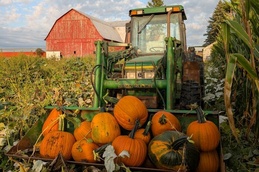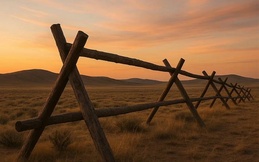
Cherries Are Who We Are: The State of the Cherry Farming Industry
Farmers battle on in a labor of love, despite a frost-reduced crop, economy uncertainty, and volatile weather
By Art Bukowski | June 28, 2025
It’s easy to get caught up in the National Cherry Festival’s fireworks, carnival rides, corn dogs, air shows, and much more. Northern Michigan’s signature event draws countless thousands to Traverse City in part because it offers a broad array of attractions for the whole family.
As with several other causes for celebration, though, it’s good to remember how it all started and what it’s all for. The festival has its roots in promoting and celebrating the region’s cherry industry, which for more than a century has contributed tremendously to our local economy and regional identity. We connected with prominent cherry farmers across our region to check the pulse of this important industry as Cherry Fest arrives.
This Year’s Crop
Cherries are very susceptible to weather events early in the growing season. The worst-case scenario is unseasonably warm weather that causes blossoms to emerge, followed quickly by freezing weather that kills these blossoms, zapping the crop (the blossoms are what develop into fruit). Such a scenario resulted in the near total loss of the region’s cherry crop in 2012.
Hail, drought, and poor pollinating conditions can also cause considerable crop loss and/or quality issues.
This year, the news ranges from bad to OK depending on who you talk to (the climatic influence of Grand Traverse Bay along with small weather bursts mean results can vary considerably, even within a few miles of each other). Generally speaking, a large amount of tart cherries were hit with some degree of frost damage, while sweets were impacted less.
“We had a lot of damage due to a frost event. We can’t really pin down when it happened, but on the north end of Old Mission, it looks like we probably did lose most of our tart crop,” says Isaiah Wunsch, a peninsula farmer with deep roots in the industry. “This is consistent with what I’ve heard from other farmers—substantial damage to tarts, but a pretty decent sweet crop.”
Over in Leelanau County, Ben LaCross grows cherries with his parents Glenn and Judy on more than 800 acres. He’s also the new president of the Michigan Farm Bureau. Like Wunsch, frost killed a lot of his tarts.
“I would suspect that we’re probably going to be around half a crop compared to normal, but that can still lead to a good yield, especially if the quality is really high,” he says.
Juliette King-McAvoy of King Orchards in Antrim County told the same story, except she also reported some hail damage.
“It’s a little early to tell what’s going to stick, but we are seeing a very reduced crop,” she says. “It’s very site specific—there’s variability between the trees on the top of the hill and the trees at the bottom—but we do think Antrim overall is hit pretty bad with frost damage. I’m hearing less than 30 percent of a crop down to even 10 percent.”
The Bad News
The cherry industry in northwest Michigan is under significant pressure from various sources. Farmers are getting lower prices for their crops, in part because of very cheap foreign imports from Türkiye and other countries. Generally speaking, farmers are also aging out and facing waning interest from the next generation, a situation that’s exacerbated by tremendous pressure to sell prime farmland for residential development.
As if all of that wasn’t enough, throw in inflation, tariffs, and concerns about the safety and availability of foreign workers due to current immigration policies, and you have a nasty mix of existing and new(er) problems to contend with.
Wunsch says he’s “definitely hearing some concerns about prices going up as a result of the trade stuff,” which isn’t a good feeling.
“[Growers] are always the last ones to get a pay raise during an inflationary cycle, and we were just starting to see some of our ag prices come up at the tail end of the post-COVID inflationary period,” Wunsch says. “It’s definitely nerve wracking to see our input costs going up again or seeing shortages of those inputs the way we did back in COVID.”
King-McAvoy says tariffs have the potential to throw a big wrench in her business.
“At King Orchards, we export quite a lot of cherry concentrate, and while those sales have not totally stopped, our buyers are sort of in a wait and see mode,” she says. “The instability is really causing problems.”
King-McAvoy is far more upset at current policies that allow cheap cherry imports while simultaneously not requiring foreign cherry ingredients to be clearly labeled on value-added products.
“I don’t want to blame consumers, because they’re doing the best they can,” she said. “Why don’t we have better labeling that protects and benefits domestic farmers?”
Global pressure will continue (though Türkiye’s cherry crop also suffered major crop damage due to frost this year, according to reports) and is among the biggest challenges going forward. Ensuring that cherry farming remains profitable is the only way to preserve the industry into the future, LaCross says.
“We need a sustainable return for our growers so they can make a profit and continue farming from one year to the next, and there’s been a lot of different pressures on those pricing structures,” he says. “Global competition for fruits and vegetables has been a big one…and so has changing consumer habits. Cherries make the greatest pie, and people don’t eat desserts as much as they [used to].”
King-McAvoy is also worried about the long-term effects of climate change, especially as weather-driven crop losses have become “increasingly common to an alarming degree.”
“We’re seeing that the Montmorency tart cherry is the most vulnerable to climate change, and it’s not adapting well to the volatile spring weather,” she says. “It’s just getting harder and harder to set a full crop.”
The data over the past quarter century is concerning, she says.
“We had a crop disaster in 2001, and then in 2012, and then back-to-back in 2020 and 2021,” she says. “Even if you’re saying only one out of every 10 years is a crop failure, that’s not a viable business model for most people.”
The Good News
While challenges abound, none of the farmers interviewed for this story are ready to throw in the towel, or even close to doing so.
King Orchards has already diversified tremendously, growing strawberries, raspberries, asparagus, peaches, apples, and much more on its 400 acres. As for the 100-ish acres of cherries that remain, King-McAvoy feels they and the thousands of additional cherry acres in the region are not beyond saving.
“I do believe the urgency is real, that farmers are on their last legs, especially if they have not diversified,” King-McAvoy said. “But I do think that if we had even a few things go our way—something as simple as a policy that doesn’t allow as many imports, or the labeling laws—it could have a real impact on [cherry] viability.”
Both King-McAvoy and LaCross are bullish about documented health benefits of cherries, which are familiar to a relatively small group of dedicated consumers and present a promising avenue for major growth as others start paying attention.
Cleveland Clinic notes that cherries have properties that fight inflammation and issues like heart disease, promote a more restful sleep (thanks to high levels of melatonin, serotonin, and tryptophan), help with muscle recovery and arthritis, improve blood sugar levels, and even lower cancer risk.
“The health benefits of cherries are superior to any other commodity out there, and when I look at growth opportunities for our fruit, I really look at that as a positive,” LaCross says. “We don’t have a huge marketing budget. We can’t do Super Bowl commercials. But we’re…continuing to strive to tell that story and bring new consumers to the cherry marketplace.”
LaCross, King-McAvoy, and Wunsch all stressed the need to generate more demand for cherries.
“One of the big things we need to do is diversify and create new value by finding new uses or markets for our products,” Wunsch says.
Wunsch’s operations are a good example of the important distinction to be made between tart cherries and sweets, which unlike tarts are mostly consumed fresh instead of being processed. This makes them much less susceptible to import pressure. That (and other factors) have led him to transition heavily into sweets.
Northern Michigan has its challenges, Wunsch says, but it’s still not a bad place to grow by any stretch.
“If you have an awareness of the coastal cost structures—how much cherry farmers in California and Washington and Oregon have to pay for land and water and those things—it’s [still a bargain] to grow here,” he says. “Long term, I’m optimistic about the future for [local] cherry production.”
And though there are many, many other items to attend to as Michigan Farm Bureau president, LaCross is also happy to use that position to aggressively advocate for his friends and neighbors in the state’s cherry industry.
“Cherries are the fabric of the agricultural community in northwest Michigan. Apples do a great job. Wine grapes do a great job, but cherries are awesome. Cherries are who we are, and we’re really proud of our cherry growers,” he says. “And so it’s one of the things that I hope to continue to be able to do in my role is to continue to tell the story of the cherry farmer and just champion everybody to eat cherries on a daily basis.”
Trending

13 Spooky Happenings Up North
It’s hard to find a town or village that does not have some sort of Halloween fun planned for residents and visitors. … Read More >>
Thrills & Chills in Cadillac
Cadillac is ready for its Halloween closeup this week! Take the kiddos to the Downtown Trick or Treat on Mitchell Street fro… Read More >>
Howling at the Moon
Your Halloween costume needs one final touch…and Northern Nail Polish has you covered. This Traverse City-based brand… Read More >>


